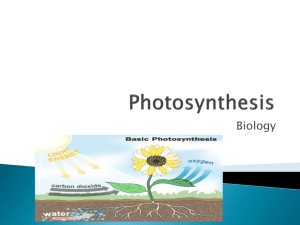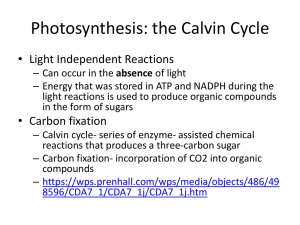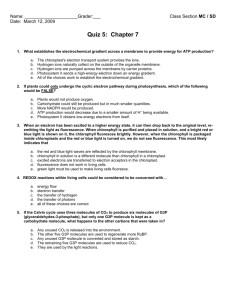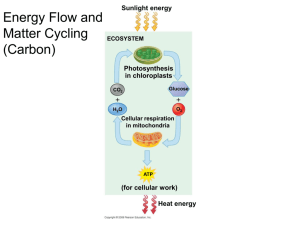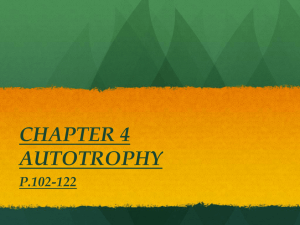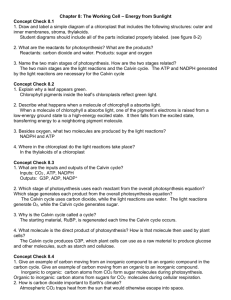Global Impact of Photosynthesis
advertisement
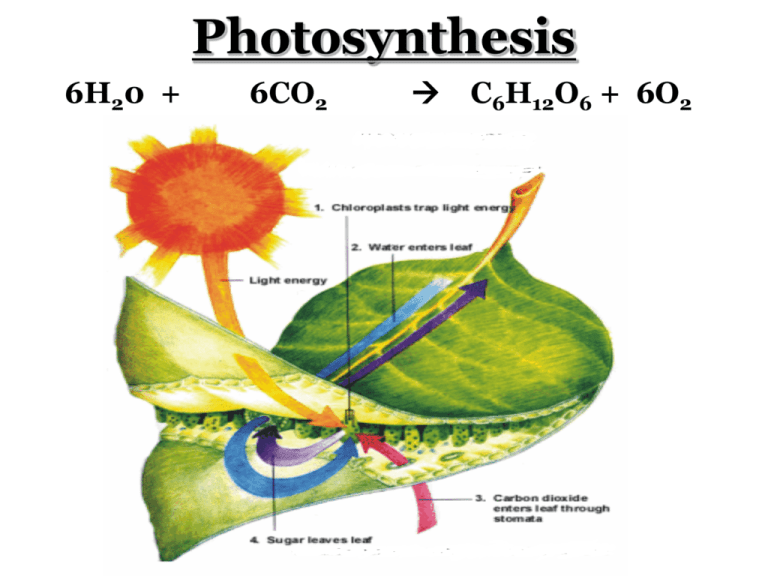
Photosynthesis 6H20 + 6CO2 C6H12O6 + 6O2 Photosynthesis Occurs in Chloroplasts of Plant Cells Plants Produce O2 Gas By Splitting Water Fates of all the atoms in photosynthesis Photosynthesis is a Redox Process Process Overview Light H2O CO2 NADP+ ADP + P Lightdependent reactions O2 Calvin cycle Sugars Visible Light Provides the Energy that Drives the Light Reactions • Which wavelengths/ color(s) are absorbed best? • Which wavelengths/ color(s) are reflected? • What is the relationship between reflection of light and the perception of color? How do Photosystems Capture Solar Power? • Plants contain the green pigment chlorophyll, clumped in photosystems, which takes in sunlight and captures it’s energy, in the chloroplasts. – There are two main types of chlorophyll, “chlorophyll a” and “chlorophyll b” • When chlorophyll absorbs light, energy is transferred to electrons in the chlorophyll molecule, raising their energy level. • These high-energy electrons make photosynthesis work. Light-Dependent Reactions Chemiosmosis Light-Dependent Reactions 1. Light is absorbed by chlorophyll in PS II (P680) 2. An electron is excited and captured by the primary electron acceptor 3. Water is split to supply electrons to PSII 4. The leftover oxygen atoms pair up to form a molecule of O2 5. The electrons released from PSII are passed to PS I by an electron transport chain 6. This “fall” of electrons down the chain provides energy to pump H+ ions across the membrane which will then power the production of ATP via chemiosmosis. (photophosphorylation_ 7. Meanwhile, light excites an electron of chlorophyll at PS I/ The primary electron acceptor captures this and an electron from the bottom of the ETC replaces the lost electron. 8. The excited electron of PS I is passed to NADP+, reducing it to NADPH The Calvin Cycle Calvin Cycle 1. Carbon Fixation: The enzyme rubisco combines CO2 with a 5-C sugar called RuBP. The product is unstable and splits into two molecules of a 3-C organic acid (3-PGA). 2. Reduction: Chemical reactions consume the energy from ATP and oxidize NADPH to reduce the 3-PGA into an energy-rich 3-C sugar (G3P) 3. Release of one G3P molecule: For every 6 G3P formed, 5 must remain in the cycle. One G3P is available to be used by the cell to make glucose and other organic compounds. 1. Regeneration of RuBP: A series of chemical reactions used energy from ATP to rearrange the remaining five G3P molecules and form three RuBP molecules so that another turn of the cycle can start. Water Conserving Adaptations • C3 plants: (majority of plants) – initially fix carbon dioxide when the enzyme rubisco adds CO2 to RuBP. (1st organic compound is 3-C acid) – If stomata close to conserve water, O2 builds up – Photorespiration occurs instead of photosynthesis • C4 plants: (ex. Corn & sugarcane) – Precede Calvin Cycle by first fixing carbon dioxide into a 4-C compound – Mesophyll cells have a high affinity for CO2 and will continue to fix CO2 even at low concentrations to allow photosynthesis to continue when stomata are closed • CAM plants: (aloe, jade & cacti) – Open stomata and intake CO2 only at night – CO2 fixed into a 4-C compound and released to Calvin Cycle during the day Global Impact of Photosynthesis •Carbon cycle •Greenhouse effect •Greenhouses gases in atm. prevent some heat from the sun from escaping •CO2, methane, H2O vapor are the main GH gases •Climate change •Excessive levels of GH gases result in more heat being trapped •This is not the same thing as ozone depletion The Ozone Layer • The ozone layer protects organisms from harmful UV radiation which is damaging to DNA (mutagen) • Ozone layer was depeleted from CFC use • Use of these chemicals is banned and the ozone layer is repairing.



